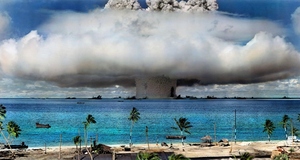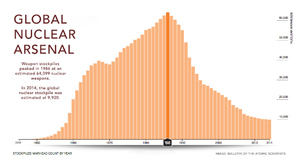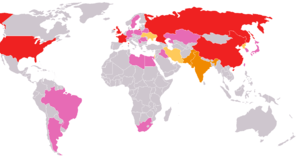From Cornell International Affairs Review VOL. 7 NO. 2U.S. Policy of Engagement Toward North Korea: Normalizing the Balance of Terror
IN THIS ARTICLE
IntroductionThe balance of terror created by the presence of weapons of mass destruction (WMDs) on the Korean peninsula has escalated the sense of uncertainty in East Asia, jeopardizing both the region’s security and progress towards political and economic cooperation. The persistent efforts of North Korea in the development of nuclear weapons present a blatant challenge to the United States’ strategic leverage in East Asia, international hegemonic influence, and global disarmament and nonproliferation initiatives. In this paper, I outline and evaluate three approaches to addressing the international threat posed by North Korea: 1) Hostile isolation through economic sanctions, intimidation, and aggressive military posturing to instigate denuclearization 2) Containment by impeding vertical and horizontal proliferation of North Korean missiles that emphasizes the maintenance of status quo over a policy of denuclearization 3) Engagement through multilateral efforts to offer political and economic incentives in exchange for gradual dismantlement of nuclear weapons production, backed by guarantees of international retaliation for failure to reciprocate. I essentially argue that isolation and containment measures have already been tried by the previous administrations and ultimately failed to secure cooperation or denuclearization because they refused to recognize nuclear weapons as the silver bullet to ensuring the regime’s survival. Thus, resolving regional instabilities entails the pursuit of a strategy of engagement and gradual normalization over an extended timetable that precedes a policy of denuclearization through economic incentives in exchange for gradual denuclearization. Consequently, dismantlement becomes a process of weaning North Korea from its military dependence on nuclear weapons for survival to economic dependence on the international community, the sustained contact leading to greater transparency and interaction with international norms. Understanding the Security DilemmaThe nature of the North Korean threat fundamentally stems from transformative changes in the international system over the last half century that has resulted in a regional imbalance of power unfavorable to North Korea. In an international system of anarchy, the capabilities and intentions of surrounding states remain unclear. While this uncertainty of the capability of states and the certainty of the outcome of nuclear war in the form of mutually assured destruction sustains the logic of nuclear deterrence, it simultaneously obfuscates the ability to distinguish “offensive from defensive capability, which lie[s] at the core of [...] the ‘security dilemma’” on the Korean peninsula.1 Conventionally viewed as an irrational aggressor, North Korea, in its political isolation following the fall of the Soviet bloc, “failing economy, lagging conventional military capabilities, and a keen desire for international acceptance and recognition” rationally turned to “asymmetric power advantages” derived from long-range missiles and weapons of mass destruction” as a means of defense to ensure regime survival in the face of South Korea’s economic and conventional military superiority, which is further enhanced by American military support.2 Intended as a defensive strategy to counter the South’s conventional advantage, the WMDs have increasingly taken on the appearance of offensive weapons as North Korea responded to escalating economic sanctions and diplomatic ostracism during the Bush administration with “coercive bargaining strategy” as the only course of action in deterring external threat.3 Hostile Isolation ApproachYet, this “‘irrationality’ of the DPRK [...] and the perceived recklessness and unpredictability of its leadership” in reaction to growing pressures served as a rallying cry for Washington to take a hawkish stance of coercive denuclearization over cooperative engagement during the Bush era that continues to sour United States-North Korean relations today.4 Proponents of isolation policy towards North Korea argue that Pyongyang’s “contacts with the outside world reflects a change in diplomatic tactics for the purpose of obtaining the food and economic aid [...] needed[ed] to stay afloat” and has not reciprocated with subsequent denuclearization nor indicated a move toward “fundamental change” in foreign policy, committing the United States to an irrational, no-exit strategy of unending concessions.5 The rationale behind engagement, they argue, thus rewards North Korea for nuclear belligerence that weakens the “credibility of U.S. security commitments in the region” and stands as a “model for other potential nuclear aspirants.”6 Location of nuclear test. North Korea’s possession of nuclear weapons has created a heightened sense of instability in the region. In response to “North Korea’s imperviousness to international pressures and sanctions,” opponents of engagement propose a “hostile isolation” approach that combines intimidating military presence with diplomatic ostracism in the form of economic sanctions, threats, and intimidation to achieve denuclearization.7 Intended to coerce North Korea towards openness and abandonment of its nuclear program under unilateral military pressures of the United States, the isolation approach pursued by the Bush administration merely exacerbated North Korea’s sense of vulnerability and ironically encouraged North Korea to turn inward to frame survival in terms of further development and enhancement of its existing nuclear capabilities.8 My main criticism of the isolation approach lies in its failure to address North Korea’s legitimate security concern as a lone state defying what it perceives to be internationallyconcerted hostility through aggressive measures by the United States that leaves no room for North Korea to maneuver without losing credibility. Subsequent antagonistic reaction by North Korea reinforces its image as a bellicose, rogue regime that creates a “vicious cycle” of misunderstanding and escalating tension.9 Furthermore, isolation provides no guarantee of preventing further horizontal (dissemination of WMD to rogue and nonstate actors) and vertical (enhancement of existing nuclear capabilities); rather, the “continuation of a comprehensive sanctions regime against North Korea may ironically strengthen the regime’s capacity to maintain political control” by trading the window of opportunity for a twoway transparency for opacity.10 Increasingly bereft of allies to mitigate economic and strategic constraints placed by international sanctions and diplomatic alienation, the regime will turn to what Cha terms, “coercive bargaining” as the only strategy for survival after careful calculation of expected costs of inaction and belligerency. Evidence of Pyongyang’s willingness to make “plain the volatility of confrontation” became evident following South Korean president Lee Myung Bak’s policy of disengagement to which North Korea retaliated by allegedly sinking South Korean warship, Cheonan, and shelling Yeonpyeong Island in the contested maritime zone near the West Sea Islands.11 Containment ApproachThe Obama administration inherited the foreign policy dilemma of a belligerent North Korea shaped by a decade-long strategy of isolation and subsequently adopted an outdated policy of Cold War-era containment as the simplest strategy to deal with North Korea, sacrificing denuclearization for a weak policy of counter-proliferation. The Obama administration’s policy of containment involves impeding further proliferation and “sophistication of [North Korean] nuclear arsenal and missile delivery capacity [...] through implementation of UN resolutions [...] by negotiating a missile moratorium or [...] ensuring that the scope of international sanctions expanded in retaliation.”12 This “‘manage and contain’ approach [that] focuses on risk reduction first” guarantees the maintenance of status quo in the region, but fails to resolve the asymmetric terror balance, which is “inherently volatile.”13 The Bush Administration, in its disregard for the nature of North Korean aggression, sacrificed regional stability and cooperation for an unviable policy of denuclearization. Pursued by the Obama administration, the containment approach proved to be an anachronistic strategy to deter nuclear proliferation, already determined to be ineffective in the strategic arms race between the Soviet Union and the United States during the Cold War. The policy of containment based on the strategy of mutual deterrence during the Cold War contradictorily led to a massive arms buildup despite both the United States and the Soviet Union attaining the minimum requirement for effective deterrence. Sharing a mutual distrust towards the other’s intentions and capabilities, each sought to overcome the security dilemma through the unchecked sophistication and production of existing arsenals weapons that ultimately escalated the costs of war but did little to change the status quo. While North Korea presents a minor threat compared to the former Soviet Union in terms of nuclear stock, it has similarly attained the minimum requirement for deterrence to effectively maintain the status quo without further proliferation - a stumbling block to ending the stagnant balance of terror on the Korean peninsula. Integrative Engagement ApproachThe failures of the isolation and containment approaches stem from their inability to recognize North Korea’s legitimate security concerns: what it perceived as aggressive, American military posturing, coupled with economic and political disengagement from North Korea that holds the key to international integration and mechanisms of transparency crucial to regional stability. The isolation policy outlines ambitious goals toward rapid denuclearization of the Korean peninsula through military threats and intimidation with no indication of reciprocal concessions by the United States. With no initial guarantees of security from the United States, North Korea responded to military aggression with reciprocal threats and subsequent policy disengagement, rescinding its former commitments toward peace and resorting to radicalization of its foreign policy. The Bush administration, in its disregard for the nature of North Korean aggression, sacrificed regional stability and cooperation for an unviable policy of denuclearization. The containment approach, on the other hand, stagnates the progress towards de-escalation of tension by purposely engaging in a patient game of checkmate with North Korea in hopes that the regime would eventually collapse on its own. The DMZ at Panmumjeom with soldiers standing guard. Since the ceasefire was signed in 1953, the 38th parallel marks the border between the two Koreas. Examining the containment policy pursued during the Cold War, the waiting game may indeed prove to be successful when weighing in the triumph of capitalism over socialism attained through sheer endurance; however, the timetable for self-collapse is measured in decades. Is an asymmetric balance of terror sustainable on the Korean peninsula for another 20 years? The persistence of the North Korean regime for over half a century indicates that we may be faced with a vastly different situation. The objective of containment is to prevent further proliferation in North Korea, yet there is no guarantee that this immense task can be achieved, especially as growing hostility drives North Korea towards greater opacity. The containment approach is thus, a no-endgame strategy, in which prospects can only improve for North Korea. Both approaches have merely emphasized North Korea’s capacity to effectively defy international sanctions, thereby undermining international standards of behavior and driving neighboring states to consider nuclear capabilities to balance North Korea’s asymmetric advantage, which shows no indication of weakening in the foreseeable future. The integrative engagement approach, however, provides an alternative to regression and stagnation of relations with North Korea by encompassing international coordination and consensus in offering “conditional diplomatic and economic inducements” that normalize relations and reduce the mutual threat through increased contact. To be successful, three points must converge on this policy approach: NormalizationThe United States must recognize that the “threat is not unilaterally posed but mutually produced” and that it must first provide reciprocal concessions in security guarantees by reconfirming political and economic commitments made in past agreements “in exchange for Pyongyang’s termination of its WMD programs” before pursuing an agenda of denuclearization.14 Addressing security concerns entails “fundamental decisions to respect [North Korea’s] sovereignty” that acknowledge the legitimacy of the regime and a mutual peace treaty outlining a maritime border and a framework of agreement.15 Examining the collapse of the Soviet Union, the fall of the Soviet bloc resulted from internal decay as gradual introduction of capitalism eroded the fundamental basis of socialist politics and economy. As increasingly liberal leaders captured state politics and opened the Soviet bloc to Western influence through policies, such as perestroika, the socialist system faltered as it grew steadily dependent on Western norms and economy. North Korea, the last defiant reminder of the Cold War, poses the same challenges the United States faced in confronting the Soviet Union. The solution, as history shows, relies not on a combination of military posturing and nuclear arms escalation, but the pervasion of Western soft power that gnaws away at the very basis of socialism through increased contact and dialogue. The solution to North Korea then relies solely on instilling the roots of soft power - economic assistance, free trade, and economic cooperation – in the region through a policy of engagement that resets a short timetable of rapid and risky policy of denuclearization to a long horizon of gradual, peaceful economic collaboration that would slowly open North Korea to international influence. Economic assistance would plant the seeds of progress and revitalization of the North Korean economy and provide a future strategic leverage as cooperation and mutual concession increasingly outweigh the benefits of coercive bargaining. Once this option becomes available and progress initiated, North Korea, recognizing the possibilities brought by cooperation, would feel increased pressure to cooperate as engagement prevents the “crystallization of conditions under which Pyongyang would calculate aggression as a ‘rational’ course of action.”16 Engagement not only improves transparency by providing insight on the degree of change in DPRK intentions, but would also “lay the groundwork for punishment if the regime fails to fulfill its obligations.”17 Moreover, increased contact would provide North Koreans with exposure to “international norms and standards” that could facilitate “grassroots-led marketization and the spread of capitalism” to undermine North Korean leadership and political control over the populace.18 Engagement thus gradually adjusts the asymmetric advantage North Korea currently exercises and tilts the balance of power in the direction of the United States. DenuclearizationThe move towards denuclearization can only be made upon the initial guarantee of economic and political security by the United States, as the North Koreans increasingly recognize the incentives for cooperation that outweigh the benefits of isolation brought by aggressive foreign policy measures. Denuclearization, more importantly, must occur at a steady but gradual pace with the premise that as North Korea grows more dependent on international aid, the “forward momentum will make it more and more difficult for the North to turn back.”19 Because complete denuclearization entails a long process of incremental dismantlement, I suggest a process of converting nuclear arms production to energy resources that North Korea can export to the international community, which would provide economic benefits and a much-needed energy source to the North Korean population. Thus, the success of denuclearization is thus tightly coupled to the success of economic inducements that convince Pyongyang the advantages of integration over nuclear proliferation. Multilateral CoordinationLearning from the Bush administration, the Obama administration adopted a multilateral approach to North Korea over bilateral negotiations but failed to secure regional cooperation with North Korean neighbors who preferred regional stability over possible costs of “violence, flows of refugees, spillover,” and absorption.20 China, a traditional ally of North Korea, exercises heavy influence over the direction of international foreign policy towards North Korea and has been effectively impeding an international push for aggressive measures towards addressing nuclear proliferation on the Korean peninsula. Previously, foreign policy experts, who recognized the immense Chinese influence over enforcing international sanctions and punishment, prioritized convincing China that “denuclearization is necessary for long-term regional stability.”21 However, China’s recent pivot towards a more aggressive and critical view of North Korea is a window of opportunity for regional cooperation towards denuclearization that must immediately be seized. The failures of isolation and containment to deter further experimentation on and proliferation of North Korean weapons of mass destruction relay the lack of clout in reinforcing the consequences of defying international standards and agreement. Thus, it is crucial to utilize the common current of distrust and discontent towards North Korea’s belligerent stance following the rise of its new leader, Kim Jong Un, to coordinate and secure an international decision framing a multilateral agreement for retaliation. The engagement approach, in which the United States first addresses the North Korean security concerns by making the initial motion for compromise, relays American willingness towards cooperation and places the burden of proof on North Korea in mutual reciprocation. With international normative frameworks and constructed identities defining international behavior, North Korea’s failures to uphold its end of the bargain would indicate that “non-confrontational manner has been exhausted” and signal the need for a concerted, international response that effectively retaliates and disincentives uncooperative measures made by North Korea.22 Normalization and eventual dissolution of tension ultimately rests on translating North Korea dependence on nuclear weapons for economic survival to dependence on international integration and mutual transparency, achieved by multilateral coordination that enforces an agreed set of framework in addressing the threat of North Korea.Continued on Next Page » Suggested Reading from Inquiries Journal
Inquiries Journal provides undergraduate and graduate students around the world a platform for the wide dissemination of academic work over a range of core disciplines. Representing the work of students from hundreds of institutions around the globe, Inquiries Journal's large database of academic articles is completely free. Learn more | Blog | Submit Latest in Political Science |





















